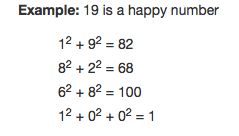Leetcode_350
给定两个数组,求他们的交集
给定 nums1 = [1, 2, 2, 1], nums2 = [2, 2], 返回 [2, 2].
题解:
python (主要使用字典)
class Solution:
def intersect(self, nums1, nums2):
"""
:type nums1: List[int]
:type nums2: List[int]
:rtype: List[int]
"""
dict1 = dict()
dict2 = dict()
for num in nums1:
dict1[num] = dict1.get(num,0)+1
for num in nums2:
dict2[num] = dict2.get(num,0)+1
return [x for x in dict2 for j in range(min(dict2.get(x,0),dict1.get(x,0)))]
C++ (使用map容器)
class Solution {
public:
vector intersect(vector& nums1, vector& nums2) {
map record;
for(int i = 0; i v;
for(int i=0; i0)
{
v.push_back(nums2[i]);
record[nums2[i]]--;
}
}
return v;
}
};
Leetcode_202
判断一个数字是不是幸福数,题目实在是太绕了,直接给出示例
这里的19就是一个happynum,如果最终结果不是1的话,那么它就不是一个happynum。
C++
#include
#include Leetcode_242
判断两个字符串是不是含有相同的字母,顺序可以不一样
#include
#include Leetcode_290
主要需要匹配pattern和str他们是否属于同一类,看下面的样例你就会明白啦
pattern = “abba”, str = “dog cat cat dog” should return true.
pattern = “abba”, str = “dog cat cat fish” should return false.
pattern = “aaaa”, str = “dog cat cat dog” should return false.
pattern = “abba”, str = “dog dog dog dog” should return false.
这边放出两个思路的代码
python
思路1:体验一下python的简洁吧
def wordPattern(pattern,str):
words = str.split(' ')
if len(words) != len(pattern):
return False
return len(set(pattern)) == len(set(words)) == len(set(zip(pattern, words)))
if __name__ == '__main__':
a = "abba"
b = "dog cat cat dog"
c = wordPattern(a,b)
print(c)
思路2:主要是建立pattern和str的映射关系,同时还要保证映射的独立。pattern是我们的key值,不同的key不能映射到相同的str上
class Solution(object):
def wordPattern(self, pattern, str):
"""
:type pattern: str
:type str: str
:rtype: bool
"""
words = str.split(' ')
if len(words) != len(pattern):
return False
hashmap = {}
mapval = {}
for i in xrange(len(pattern)):
if pattern[i] in hashmap:
if hashmap[pattern[i]] != words[i]:
return False
else:
if words[i] in mapval:
return False
hashmap[pattern[i]] = words[i]
mapval[words[i]] = True
return True
Leetcode_205
几乎和290是一样的模型,还是判断两个输入的模式是否一样,注意看下面的样例
For example,
Given "egg", "add", return true.
Given "foo", "bar", return false.
Given "paper", "title", return true.
这里我就放出最常规的解法
python
def isIsomorphic(s, t):
if len(s)!=len(t):
return False
hashmap = {}
val = {}
for i in range(len(s)):
if s[i] in hashmap:
if hashmap[s[i]] != t[i]:
return False
else:
if t[i] in val:
return False #防止不同的key映射到同一个value上#
hashmap[s[i]] = t[i]
val[t[i]] = True
return True
Leetcode_451
按照字母出现的频率逆序排序,请看具体的示例
Example 1:
Input:
"tree"
Output:
"eert"
Explanation:
'e' appears twice while 'r' and 't' both appear once.
So 'e' must appear before both 'r' and 't'. Therefore "eetr" is also a valid answer.
Example 2:
Input:
"cccaaa"
Output:
"cccaaa"
Explanation:
Both 'c' and 'a' appear three times, so "aaaccc" is also a valid answer.
Note that "cacaca" is incorrect, as the same characters must be together.
Example 3:
Input:
"Aabb"
Output:
"bbAa"
Explanation:
"bbaA" is also a valid answer, but "Aabb" is incorrect.
Note that 'A' and 'a' are treated as two different characters.
python 再次感叹python的简洁和强大
import collections
def frequencySort(s):
count = collections.Counter(s).most_common()
res =''
for c,v in count:
res += c*v
return res
if __name__ == '__main__':
a = "abbcd"
s = frequencySort(a)
print(s)
注意我们这边都是以真实环境能够跑的代码呈现为主的,提交的时候需要去掉一些导入和main函数
Leetcode_01_two_sum
找出数组里面的两个数字,使得他们的和等于我们的目标数,返回我们找到的两个数的下标
#include
#include
#include Leetcode_15_3_sum
从数组中选择三个元素和为零
#include
#include
#include
using namespace std;
/// Using Hash Table to store all the numbers
///
/// Time Complexity: O(n^2)
/// Space Complexity: O(n)
class Solution {
public:
vector> threeSum(vector& nums) {
unordered_map counter;
for(int i = 0 ; i < nums.size() ; i ++)
counter[nums[i]] ++;
vector> res;
if(counter[0] >= 3)
res.push_back({0, 0, 0});
// Remove duplication
sort(nums.begin(), nums.end());
vector::iterator iter = unique(nums.begin(), nums.end());
nums.erase(iter, nums.end());
for(int i = 0 ; i < nums.size() ; i ++)
for(int j = i + 1 ; j < nums.size() ; j ++){
if(nums[i] * 2 + nums[j] == 0 && counter[nums[i]] >= 2)
res.push_back({nums[i], nums[i], nums[j]});
if(nums[i] + nums[j] * 2 == 0 && counter[nums[j]] >= 2)
res.push_back({nums[i], nums[j], nums[j]});
int c = 0 - nums[i] - nums[j];
if(c > nums[j] && counter[c] != 0)
res.push_back({nums[i], nums[j], c});
}
return res;
}
};
int main() {
vector nums1 = {-1, 0, 1, 2, -1, -4};
vector> res = Solution().threeSum(nums1);
for( int i = 0 ; i < res.size() ; i ++ ){
for( int j = 0 ; j < res[i].size() ; j ++ )
cout< 这里也提供一个简单的Python思路,使用对撞指针来做
def threeSum(nums):
res = []
nums.sort()
for i in range(len(nums)-2):
if i>0 and nums[i]==nums[i-1]:
continue
l,r = i+1, len(nums)-1
while l0:
r-=1
else:
res.append((nums[i],nums[l],nums[r]))
while l Leetcode_18_4sum
vector> fourSum(vector& nums, int target) {
vector> total;
int n = nums.size();
if(n<4) return total;
sort(nums.begin(),nums.end());
for(int i=0;i0&&nums[i]==nums[i-1]) continue;
if(nums[i]+nums[i+1]+nums[i+2]+nums[i+3]>target) break;
if(nums[i]+nums[n-3]+nums[n-2]+nums[n-1]i+1&&nums[j]==nums[j-1]) continue;
if(nums[i]+nums[j]+nums[j+1]+nums[j+2]>target) break;
if(nums[i]+nums[j]+nums[n-2]+nums[n-1]target) right--;
else{
total.push_back(vector{nums[i],nums[j],nums[left],nums[right]});
do{left++;}while(nums[left]==nums[left-1]&&left Leetcode_454
四个数组,abcd,求abcd四个数组元素和为0的个数
#include
#include leetcode_447
#include
#include leetcode_219
bool containsNearbyDuplicate(vector& nums, int k)
{
set rec;
for(int i = 0; i Leetcode_206
反转链表
#include
using namespace std;
struct ListNode
{
int val;
ListNode *next;
ListNode(int x): val(x),next(NULL) {}
};
ListNode* reverseList(ListNode* head)
{
ListNode *pre = NULL;
ListNode *cur = head;
//ListNode *next = head->next;
while(cur!=NULL)
{
ListNode *next = cur->next;
cur ->next= pre ;
pre = cur;
cur = next;
//next = next->next;
}
return pre;
}
